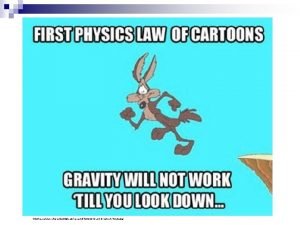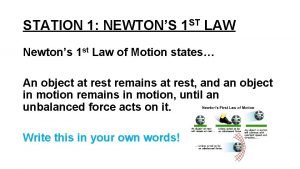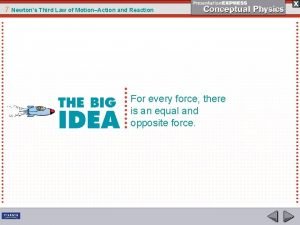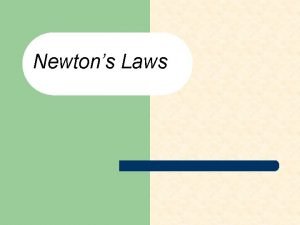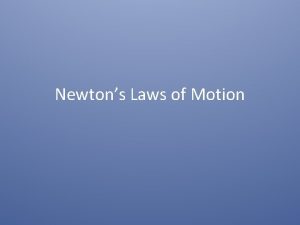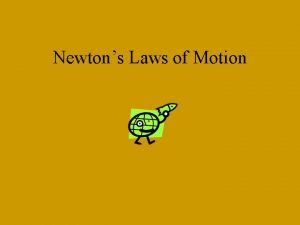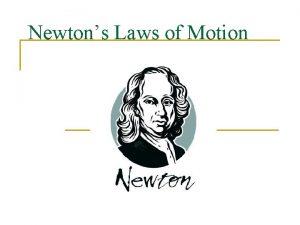NEWTONS LAWS OF MOTION Newtons first law Every











- Slides: 11

NEWTON’S LAWS OF MOTION

Newton’s first law Every object in motion tends to remain in motion unless an external force is applied to it. The same applies to an object at rest.

What does this mean? • An object at rest will remain at rest and an object in motion will remain in motion unless something happens to them. • On earth the something that happens is often friction or air resistance. • Examples: • Chairs and tables don’t move on their own. • A ball rolled across the floor will eventually stop because of friction caused by its contact with the floor. • Satellites in space keep going without propulsion because of the lack of particles to cause friction in space • When playing pool you hit balls in particular places to cause them to move in specific directions.

Newton’s second law F = ma: This is the relationship between an object's mass m, its acceleration a, and the force applied to it, F.

What does this mean? • Force is directly proportional to acceleration, so if I increase the force on an object then I will increase its acceleration, and if I decrease the force on an object then I will decrease its acceleration. • Force is also directly proportional to the mass of the object, so if I have a larger mass then I must apply a larger force to get the same acceleration. • Mass is indirectly proportional to acceleration, so if I have a larger mass its acceleration will be less than that of smaller mass object using the same force to cause the acceleration.

• Examples: • You would rather have a small Honda run into your car at 35 mph than a large truck at the same velocity because the larger mass means a larger force and thus more damage to your car. • The harder you hit a baseball, the farther it will go because a larger force is acting on the same mass. • A bowling ball and a softball dropped from the same height at the same time will hit the ground at the same time, but the bowling ball will make a deeper hole in the ground because of its mass.

Newton’s third law For every action there is an equal and opposite reaction.

What does this mean? • Every time you have a movement or a push in one direction there is the same amount of movement or push in the opposite direction. • Examples: • When a rocket takes off the combustion of fuel pushes downward, forcing the rocket to move upward. • When you shoot a rifle the bullet moves forward, forcing the stock backward into your shoulder. • The amount of stretch you give to a rubber band (force) will determine how much recoil (opposite force) it has. The more you stretch it the further you can shoot it.

Reminder about levers • Levers consist of an force or effort and force arm, a resistance or load and resistance arm, and a pivot point or fulcrum. • Force X length of force arm = resistance X length of resistance arm. • The mechanical advantage (MA) = length of the force arm divided by length of the resistance arm. This means that you have a greater mechanical advantage if the force arm is longer than the resistance arm. • Mechanical advantage indicates how much easier a job is to complete while using a simple machine. It is the ratio of resistance force to effort force.

Types of levers • First class = force – pivot – resistance • The force has MA if it is farther from the pivot than the resistance. • Examples: seesaw, crowbar • Second class = pivot – resistance – force • The force always has MA because by definition it has to be further from the pivot than the resistance. • Examples: opening a door, using a stapler • Third class = pivot – force – resistance • The force never has MA because by definition it is closer to the pivot than the resistance. • The lack of MA is compensated for by the fact that you get a greater range of motion for the resistance with little motion by the force. • Examples: opening a door if you push on the wrong side, a catapult

Atlatls are a third class lever system • The extension of the forearm (the forward throwing motion) uses the elbow as the pivot point; the triceps muscle is the force and it is attached to the forearm a short distance further on the forearm; the resistance is the object held in the hand furthest out from the pivot. • The flick of the wrist at the end of the throwing motion is also a third class lever system. • The triceps produces the force with very little motion and the end of the atlatl moves over a great distance thrusting the spear forward with great momentum.
